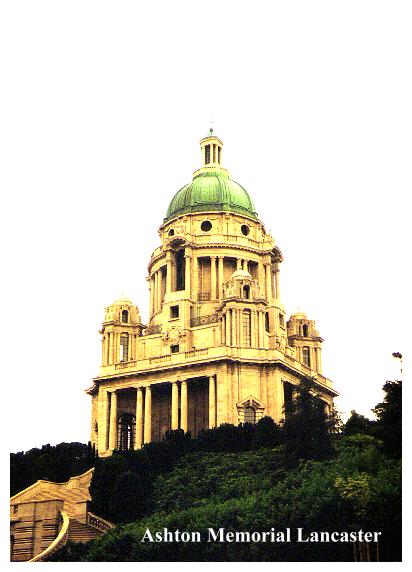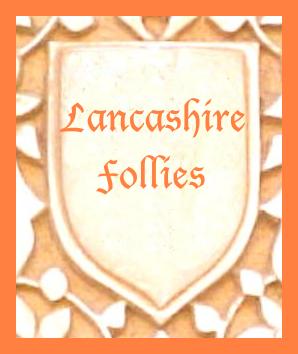7. THE ASHTON MEMORIAL
Simply the biggest folly in Britain - Lancashire's answer to the Taj Mahal.
Getting there: Located in Williamson Park, due east of Lancaster town centre. Take the Trough of Bowland road towards Hornsea Pottery.
Map ref: SD 494 615 Kendal & Morecambe. Landranger sheet 97
Rating Follies and General Interest ***
Lancashire can lay claim not only to Britains' biggest prospect tower on the golden mile in Blackpool, but also to the nation's most massive folly which is situated in Williamson Park on the outskirts of Lancaster. With its massive green dome and majestic appearance it is a prominent landmark, especially when viewed from the nearby M6. It looks like a library, a public building attached to a university perhaps, but the truth is that this fabulous structure, a masterpiece of Edwardian Baroque architecture reminiscent of the earlier masterpieces of Wren, Hawksmoor and Vanbrugh serves no useful function whatsoever. This is as good a definition of a folly as you can get!! The building is clad in white portland stone, but its heart is (metaphorically speaking) made from lino!
James Williamson was the second son of James Williamson senior,who ran an oil cloth and linoleum business in Lancaster. It is the usual story. Born in 1842, James Williamson (Junior) worked all his life in the linoleum business, starting work in his father's shop, and eventually taking full control of the business in 1875. He expanded the firm, became a multi-millionaire in the process, and was responsible for laying linoleum on parlour floors from Dallas to Darwin, becoming known as the Lino King in the process. Williamson was to Lancaster what Lord Leverhulme was to Bolton - simply its chief employer and greatest philanthropist. Honours were showered on him. Appointed High Sherriff of Lancaster in 1885, he followed this up by serving as Liberal MP for Lancaster from 1886 to 1895. In 1895 he was created a peer of the realm assuming the title Baron Ashton of Ashton, after his country seat near Lancaster. Eventually however, he forsook Lancaster for Lytham St Annes, where he died in 1930 at the age of 88 - an eccentric recluse.
The first Williamson to make his mark upon the Lancaster landscape was James Williamson senior, who began the laying out of Williamson Park in the 1870s. A carriage drive and gravel paths were constructed to provide relief work for laid off operatives during the Cotton Famine. The top of the carriage drive was known as the 'Top of Hard Times'. A stone seat bearing the incription 'Rev. T.R, London 1863' survives from this period. The plan was to include elaborate landscaping with an ornamental lake and an artificial waterfall. It was a formidable undertaking, and Williamson never lived to see his work completed. That task fell to his son - Lord Ashton.
James Williamson junior gave the park to Lancaster Corporation in 1881, and it was formally opened for public use in 1896. In 1904 the Park was improved and Sir John Belcher was commissioned to design a temple, a fountain, a palmhouse and last, (but by no means least) the Ashton Memorial.
Ashton's masterpiece was intended to be a Memorial to his first wife, Margaret Gatey, who had died in 1877, but this resolve was diluted somewhat when he remarried in 1880. His second wife, Jessie Hume, died in 1904, and Williamson married yet again in 1909, this time to Florence Maud Whalley, a prosperous widow. In the end, Lord Ashton simply dedicated his memorial to 'deceased relatives'!!
The Ashton Memorial (or, as it is known locally, the 'Jelly Mould') cost #87,000 to build, a fabulous sum in those days. The contractors were Waring and Gillow of Lancaster, better-known in their role of cabinet makers. From the very beginning there were problems. Originally conceived as a solid stone structure, rising costs forced the contractors to 'experiment' with cheaper materials - load-bearing brick, steel girders and stone-clad concrete, all of which were to lead to major structural problems in the course of time.
All the same the Memorial is a wondrous constructional cocktail. Its staircases and facades are of Cornish granite, Derbyshire limestone and some 300 tons of finely-worked stone masonry. The monument stands 150 feet high at the summit of the park, and the sense of height is further heightened by the enormous flight of steps on its western side. The interior consists of two domed chambers, one on top of the other, with a host of steps leading out onto various balconies. It is well adorned with frescoes and sculptures. Within the lower dome are four large figure groups painted by George Murray. They represent Commerce, Art, History and Science. These groups are separated by figures representing the four seasons, accompanied by the arms of Lancaster. Sculptured figures, representing similar themes, are found on the exterior of the dome - Science, for example, carries some lab apparatus and a telephone.
When nearly completed, the building was opened without ceremony on the 24th October 1909.
In 1920 the memorial was reported as being in need of repair. Rain had percolated through the structure and had reacted with impurities in the concrete, causing it to crack. This in turn had exposed the steel joists to the elements, making them corrode. Lord Ashton, though now long fallen out of love with his native town, nevertheless provided funds for the repair of his gigantic white elephant, and after his death his widow continued to do so.
In 1942 the adjacent palm house was damaged by fire and its contents destroyed; and twenty years later, in 1962, the dome of the memorial suffered a similar fate. Attempts were made to preserve the building, but by 1981 it was in such a state of disrepair that it had become structurally unsound and had to be finally closed to the public.
This story however has a happy ending. After an estimate that around 600,000 pounds would be required to restore the memorial an appeal was launched, and with the help of many benefactors the local council was able to undertake a complete restoration of both the memorial and the palm house. Work took place from 1985 to 1987, and in May 1987 the Ashton Memorial was finally re-opened to the public.
Williamson Park today is a delight. Parking is free, and it is a marvellous place to picnic and enjoy the fine views over Lancaster and across Morecambe Bay to the Lakeland mountains. The palmhouse has been restored and is now a butterfly house, and there is an adjacent giftshop and cafe. The memorial itself is now open to the public, and admission is free to the lower dome, where there is a fine exhibition on the life and times of Lord Ashton. It is also a popular backdrop for outside theatrical productions. Lancaster, it would seem, beginning to find some worthwhile uses for the Jelly Mould' after all...................!!








